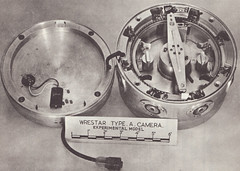WRE

|
| Lens Diagram of the Dixon Ultra Wide Angle Lens image by Dirk HR Spennemann (Image rights) |
The Weapons Research Establishment (located in Salisbury, South Australia) was managed by the Commonwealth of Australia's Department of Supply and collaborated with various defense contractors.[1] In conjunction with the Joint Anglo-Australian Missile Testing program,[2] WRE developed an ultra-wide 186° fish-eye lens (design by RA Dixon [3][4]). This lens found application in a number of specialised cameras:[5]
WRECISS
The Weapons Research Establishment Camera Interception Single-Shot WRECISS unit (developed 1957) was mounted in the nose telemetry bay of the surface-to-air missile. Although the firing lever must be replaced after each mission, it was estimated that some 30 per cent of the units could be re-used without repairs and a substantial further proportion could be repaired relatively cheaply. WRECISS shot single negatives using 0.93in discs punched from 35 mm Ilford Photo SR101 film., exposure time 0.3 millisec
- Weight 801; diameter 1.5in; length 1.25in; field of view 186 ° (Dixon lens); effective relative aperture, approximately f/8; 192 cameras were made in the initial production run.[6]
WREROC
The Weapons Research Establishment Roll Orientation Camera (see entry: WREROC) was developed to record the roll (rotation) of a missile in flight in relation to the horizon. The coverage of the ultra-wide angle Dixon lens was restricted to a narrow slit. The 35mm colour negative film was moved at a constant speed past the slit so that the resulting image is a continual strip that shows the horizon throughout the duration of the flight.[7]

|
| WRESTAR-A image by Dirk HR Spennemann (Image rights) |
WRESTAR
The Weapons Research Establishment Small Target Aircraft Recorder (WRESTAR-A) was a camera designed to form the centre section of a towed Rushton airfcraft target. The camera, which measures 190mm in diameter, carries eight ultra-wide (186 degree) Dixon lenses. The camera was desined that it successively exposed four image pairs (using diametrically opposed lenses) over a period of 30 milli-seconds. Each lens pair cover the entire sky around the target.[8]
WRETAR
While technically the Weapons Research Establishment Target Aircraft Recorder (WRETAR) is a high speed cine camera mounted on a target aircraft. The resulting negatives were not projected as a film but examined individually in order to assess the miss distance of the missile in relation to its target.[4]
Notes
- ↑ Such as Fairey Aviation Co of Australasia Pty Ltd (later merged into AWA Defence Industries of Australia).
- ↑ For back ground see: Morton, Peter (1989) Fire across the desert. Woomera and the Anglo-Australian Joint Project 1946–1980. Canberra : AGPS; as well as Twigge, S.R. (1993) The early development of guided weapons in the United Kingdom, 1940-1960. London: Routledge.
- ↑ ‘Wide Angle Lens Systems.’ US Patent Filed 23 Dec 1957; Issued 18 Dec 1962. Applicants: Robert P. Bonnell, Jack V. Ramsey and Francis Alfred Thomas Dixon, assigned to The Commonwealth of Australia. US Pat. Nº 306875
- ↑ 4.0 4.1 Dixon, F.A. (1961) Cameras with Wide Fields of view used in Rocket Research at the Woomera Range, South Australia. In: K.J. Habell (ed.), Proceedings of the Conference on Optical Instruments and Techniques London 1961. New York: John Wiley & Sons. Pp.273-278.
- ↑ Many of the lenses used for the WRETAR, WRECISS and WREROC cameras were produced by Etherington Optical in Mildura, Victoria: Edgar, Don (2000) Obituary Reginald Robert Etherington. Clinical and Experimental Optometry vol. 83 nº 4, pp. 234-235.
- ↑ Missiles and Spaceflight. Flight 1 January 1960, p. 4
- ↑ For an in-depth description, see Spennemann, Dirk HR (2015a) History, Description and Technical Details of the WREROC missile cameras. vers. 1.0. CAMERA | TOPIA (Albury NSW)
- ↑ Spencer, F. (1969) WRESTAR-A (Weapons Research Establishment Small Target Aircraft Recorder Type A). Weapons Research Establishment Technical Note PD 98 (February 1969). Salisbury (South Australia): Weapons Research Establishment, Department of Supply